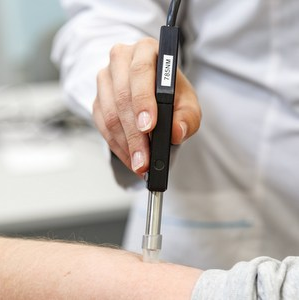Now renal insufficiency and other health problems can be detected in mere minutes by simply applying a special laptop-controlled laser spectrum analyzer on the patient's skin surface. It detects changes in the biochemical composition of skin, which appear as inherent metabolic processes take place in human body.
In addition to this device, researchers at Samara National Research University (Samara University) are developing a multi-purpose method of optical diagnostics (1) of socially significant diseases. This method will make the work of doctors easier and speed up the diagnostic process. The research is being carried out jointly with colleagues from Samara State Medical University. The findings of Samara scientists on the topic of optical diagnostics have been published in one of the most reputable scientific journals that covers interaction between light and living tissues –
Journal of Biophotonics.
“Our project (2) aims to create a method for analyzing the surface of human skin in order to detect such physiological conditions of the body as renal insufficiency in the context of the patients’ age and gender. We plan to develop a multi-purpose optical method, which will include the test of skin surface using Raman spectroscopy (3) and subsequent multivariate analysis of obtained experimental data. To analyze the databases of spectral characteristics of the patients’ skin surface, we plan to use the neural network method. It will make it possible to create a self-learning algorithm for detecting metabolic changes in the human body,” says Lyudmila Bratchenko, Junior Researcher at the Research Laboratory "Photonics" and postgraduate student at the Department of Laser and Biotechnical Systems of Samara University.
According to her, socially significant diseases alter the water, electrolyte and nitrogen balance in the human body and trigger a number of other changes in the body's metabolism. The characteristics of metabolism and skin composition are also influenced by gender and age factors. Raman spectroscopy helps reveal these changes and their special features.
“Changes in normal metabolism are accompanied by changes in the composition of body tissues, including the skin. Therefore, a skin test can reveal various health problems, such as kidney disease, or detect the formation of neoplasms,” Lyudmila Bratchenko said.
The project is based on the findings of studies on the topic of optical diagnostics of skin neoplasms and kidney diseases previously conducted by scientists from Samara University and Samara State Medical University (4). Experimental diagnostics of patients with the help of the optical dermal biopsy method were carried out at Samara Regional Clinical Hospital named after V.D. Seredavin.
“We use the optical skin biopsy to determine biochemical properties of skin using the laser radiation method and the Raman effect. It allows us to detect whether the person being examined has a kidney disease. Our diagnostic method, in contrast to others, requires no surgery, blood testing or any other invasive procedures. The proposed approach allows us to determine, in a matter of minutes, whether a patient has any developing kidney problems. At the same time, this method does not cause any discomfort to the patient,” says Ivan Bratchenko, Assistant Professor of the Department of Laser and Biotechnical Systems at Samara University.
According to Bratchenko, 85 people were included in the experimental sample at Seredavin Hospital. The researchers directed the spectrum analyzer to the patient's forearm and recorded spectral information read from the patient’s skin surface over the period of one minute. The information was then processed within a few more minutes. This kidney disease diagnostic method proved to be sufficiently accurate – 96–98% for different age groups.
Some 100 people are expected to be tested as part of the project of health problems diagnostics using the optical method. The sample will include healthy people as well as patients with various conditions, including hemodialysis-dependent patients. The testing will be done with the help of an experimental stand and a portable spectrum analyzer; a laser beam with the excitation wavelength of 785 nm will be used. Various classifiers will be tested for the analysis of the obtained data.
“The proposed method for analyzing spectral characteristics of the skin surface will create a fundamentally new approach for studying physiological states of the human body. In particular, the method we are developing can help assess the condition of patients with chronic kidney diseases. According to statistics from the World Health Organization, almost 10% of the world's population suffer from kidney diseases, and millions of people die from kidney problems every year. Our research will also contribute to decisive progress in developing other high-tech optical devices for non-invasive diagnostics,” Lyudmila Bratchenko said.
For reference
(1) Optical non-invasive diagnostics employs an optical (usually laser-based) method for examining the patient's tissues. The analysis of spectral data obtained during the testing makes it possible to define biochemical changes occurring in human tissues during the development of various physiological conditions, including diseases.
(2) The project is being implemented within the framework of a grant provided by the Russian Foundation for Basic Research for best scientific research projects carried out by young scientists attending postgraduate school. The project delivery time is two years. The amount of the project grant is RUB 1.2 million.
(3) Raman spectroscopy is a type of spectroscopy that uses the ability of the studied molecules to produce Raman scattering of monochromatic light (laser radiation). The spectrum of scattered radiation reveal spectral lines that are absent in the spectrum of primary (exciting) light. The number and location of the newly appeared spectral lines depend on the molecular structure of the investigated substance, which enables detecting certain changes in the tissues.
